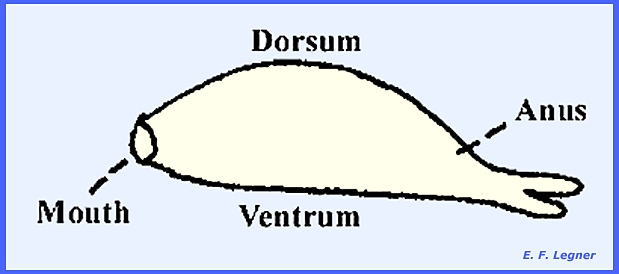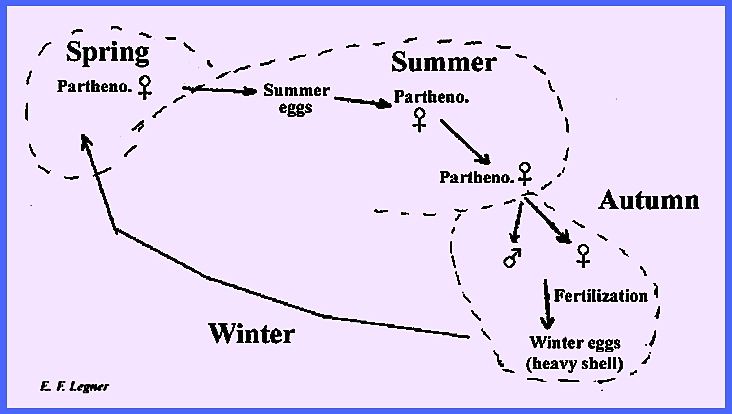File:
<rotifera.htm> <Index to Invertebrates> <Bibliography> <Glossary> Site Description
<Navigate to Home>
|
Invertebrate
Zoology Kingdom: Animalia, Phylum: Rotifera (Contact)
CLICK on underlined file names and included illustrations to
enlarge: The Phylum: Rotifera derives its
name from "Bearing a wheel" or "Wheel
animacules." There is a prominent circular array of cilia
at the anterior end of the animal that looks like a rotating wheel. This is known as the Trochal
disc
or Corona. Rotifers occur primarily in freshwater and
all are microscopic. They possess a
set of chewing structures called mastax with
teeth, which is located down in the pharynx and used for food shredding. A representative Genus is Hydatina,
which is a common freshwater rotifer. Body Plan.--
There is bilateral symmetry and the mouth is located at the ventral edge of
the trochal disc. The trunk is the
main part of the body, and there is a foot with two toes that is forked at
the posterior end. The anus is
located mid dorsally. Body Wall.--
A cuticle is secreted by the epidermis.
The epidermis is a syncytium with no cell boundaries. The muscles do not occur in distinct
layers but are scattered around in bundles and individual fibers. Thus they do not form a continuous layer. Body Cavity.--
This consists of a pseudocoelom. Food & Digestion.--
The food is of microscopic bacteria, protozoa and algae. The food is collected by means of a water current
set up by the trochal disc and carried down into the mouth. The mouth empties into a pharynx where it
is "chewed" by the mastax.
The food is then passed through a short esophagus and into a large
stomach. Digestion is aided by
digestive juices, which are secreted by gastric glands located
near the anterior end of the stomach.
Absorption occurs here also.
The stomach gives way to the intestines and finally enters the cloaca,
which is a common cavity for excretory, reproductive and digestive systems. Circulation, Respiration &
Excretion.-- The distribution of
materials through the pseudocoelom is accomplished by a simple
"slopping" around and diffusion.
Respiration is by diffusion.
Flame cells perform excretion.
They occur in a definite number and pattern and empty into a coiled
pair of excretory ducts, which join at the
posterior end where they form an elaborate bladder that
runs into the cloaca. Support & Protection.--
The cuticle supports the animal as do the muscles. The fluid-filled sac also affords support. They are able to avoid some hazards by
movements away. Locomotion.
-- There are two kinds of locomotion: (1) ciliary activity on the corona and
(2) crawling on vegetation by making particular use of the foot. Pedal glands secrete
adhesive material, which comes out on the foot. It can thus adhere to surfaces. The movement is of "inch-worm" type. Some rotifers are sessile and live in a
gelatinous case that is secreted around them and sometimes bound by their
faeces. Sensitivity.--
Rotifers are sensitive all over their body and especially on the trochal
disc. There are some tactile
structures on the corona and a dorsal feeler, eyespots and olfactory sensory
areas. These are all retractile and
can be pulled back into the body. Nervous System.-- A brain of
fair size lies dorsal to the mastax.
One large nerve runs directly to the dorsal feeler, and small nerves
run to various other body parts. Reproduction.--
The sexes are separate and there is considerable difference between them, the
male being small and degenerate.
Males are also extremely rare.
They possess an underdeveloped trochal disc, the remnant of a
digestive tract, but their muscles are well developed. Excretory structures are present, but the
main organs are reproductive. They
have a projected penis. The female ovary has a germarium,
which produces egg cells, and a vitellarium that
produces yolk cells. Both are
entralecithal. The oviduct leads away
from the germarium and to the cloaca and outside. It may be swollen over one area that is called the uterus. Reproduction runs through a cycle
in which at first only parthenogenesis occurs but which is terminated by
sexual reproduction (see Life Cycle diagram below). Copulation.--
This is done by Hypodermic Impregnation,
where the male's penis punctures the body wall of the female and introduces
sperm directly into the pseudocoelom. Life Cycle.
-- There are three groups of Rotifera:
(1) separate sexes are all alike and occur in the marine environment,
(2) there is alternation between parthenogenesis and fertilization and (3)
only females are present that multiply by parthenogenesis. Numbers 2 & 3 occur in freshwater. Ecology. -- Rotifera
are extremely resistant to environmental differences, particularly to
desiccation. They may survive for
several years in the desiccated state.
The entire body shriveling up after which it may be blown around by
the wind, carried by humans and animals, etc, accomplishes this. Normal activity will resume upon coming
into contact with water again. Most species of Rotifera are
worldwide in distribution, and their winter eggs are likewise resistant to
extremes. Economic Importance.
-- There is no direct economic importance, but indirectly they live off of
primary producers. Variation
in Body Plan. -- There is great
variation in the body plan. For
example some species are sessile, other free living. The corona is variously modified, some
species are case builders and some are viviparous. The Genus Asplanchna has a digestive tract that stops after the
stomach. Cell Constancy.
-- This is like Acanthocephala in that there is a limited number of egg cells
but not sperm. ------------------------------------ Please see
following plate for Example Structures of the Rotifera: Plate 32
= Phylum: Rotifera: Hydatina senta --
Lateral view ============== |


